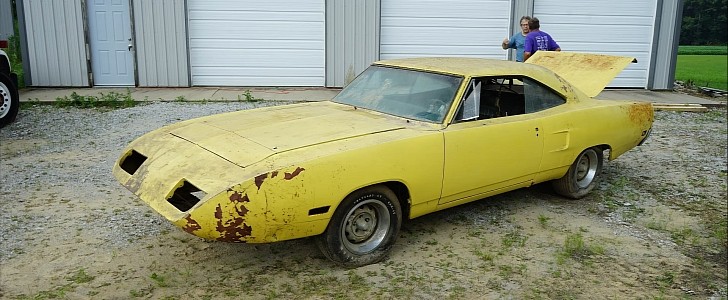Back in the late 1960s, NASCAR racing got so ridiculous that Dodge was allowed to race a Charger with a massive wing on its tail. Yes, I'm talking about the Charger Daytona, one of the two "winged warriors" that Mopar developed at the time. The other one was the Plymouth Superbird.
Introduced in 1969, the Charger Daytona went on to win the NASCAR championship in 1970. To homologate the car for racing, Dodge built 503 road-going examples. Plymouth's take on the winged racer, the Superbird, arrived in 1970. But unlike Dodge, Plymouth built almost 2,000 units for road use. It is believed that more than 1,000 of them have survived to this day, but the Superbird is still a rare... uhm... bird.
That's why seeing one of these winged Mopars emerging out of storage is an important event. In this case, we're looking at an example that's going to a new home, where it will get the attention it needs. After sitting for no fewer than 35 years.
The early history of this aero Plymouth is unknown, but it seems that the Superbird has been spending time with the same owner since the 1980s. The car was driven for a while and then put into storage. But not before some of its components, like the wing and the headlamp buckets, were removed for safekeeping.
Unfortunately, this Superbird also went through some modifications in its early life. The yellow color might seem original at first glance, but it's actually the car's third layer of paint. Before it was refinished in yellow, this coupe used to be red. And before that, it sported the factory-original Petty Blue. You can see traces of it in the engine bay and the trunk.
What's more, the vinyl roof has been removed at some point. Yes, that's one of the features that set the Charger Daytona and the Superbird apart. While the former had a standard, metal roof, the Superbird came with a vinyl top.
As for what's under the hood, this Superbird flaunts a 440-cubic-inch (7.4-liter) V8 with a four-barrel carburetor. The entry-level unit for the 1970 Superbird was rated at 375 horsepower. Plymouth also offered a six-barrel 440 good for 390 horses and the mighty 426 (7.0-liter) Hemi with 425 horsepower on tap.
On top of being the least powerful V8, the 440 four-barrel is also the most common engine choice in the Superbird. Plymouth reportedly built only 135 cars with the Hemi and 716 with the six-barrel 440, which leaves more than 1,000 examples fitted with the four-barrel 400. But while it might not be the most desirable Superbird engine, it's a numbers-matching unit and that's quite the rare feat.
Granted, the Mopar doesn't look all that great inside and out, but it's in fair condition considering it spent more than three decades in storage and went through at least a couple of repaints. But the good news is that it's going to a new home. One that will provide a much-needed restoration. And seeing it rolling out of its resting place is as glorious as they get. Check it out in the video below.
That's why seeing one of these winged Mopars emerging out of storage is an important event. In this case, we're looking at an example that's going to a new home, where it will get the attention it needs. After sitting for no fewer than 35 years.
The early history of this aero Plymouth is unknown, but it seems that the Superbird has been spending time with the same owner since the 1980s. The car was driven for a while and then put into storage. But not before some of its components, like the wing and the headlamp buckets, were removed for safekeeping.
Unfortunately, this Superbird also went through some modifications in its early life. The yellow color might seem original at first glance, but it's actually the car's third layer of paint. Before it was refinished in yellow, this coupe used to be red. And before that, it sported the factory-original Petty Blue. You can see traces of it in the engine bay and the trunk.
What's more, the vinyl roof has been removed at some point. Yes, that's one of the features that set the Charger Daytona and the Superbird apart. While the former had a standard, metal roof, the Superbird came with a vinyl top.
As for what's under the hood, this Superbird flaunts a 440-cubic-inch (7.4-liter) V8 with a four-barrel carburetor. The entry-level unit for the 1970 Superbird was rated at 375 horsepower. Plymouth also offered a six-barrel 440 good for 390 horses and the mighty 426 (7.0-liter) Hemi with 425 horsepower on tap.
On top of being the least powerful V8, the 440 four-barrel is also the most common engine choice in the Superbird. Plymouth reportedly built only 135 cars with the Hemi and 716 with the six-barrel 440, which leaves more than 1,000 examples fitted with the four-barrel 400. But while it might not be the most desirable Superbird engine, it's a numbers-matching unit and that's quite the rare feat.
Granted, the Mopar doesn't look all that great inside and out, but it's in fair condition considering it spent more than three decades in storage and went through at least a couple of repaints. But the good news is that it's going to a new home. One that will provide a much-needed restoration. And seeing it rolling out of its resting place is as glorious as they get. Check it out in the video below.









